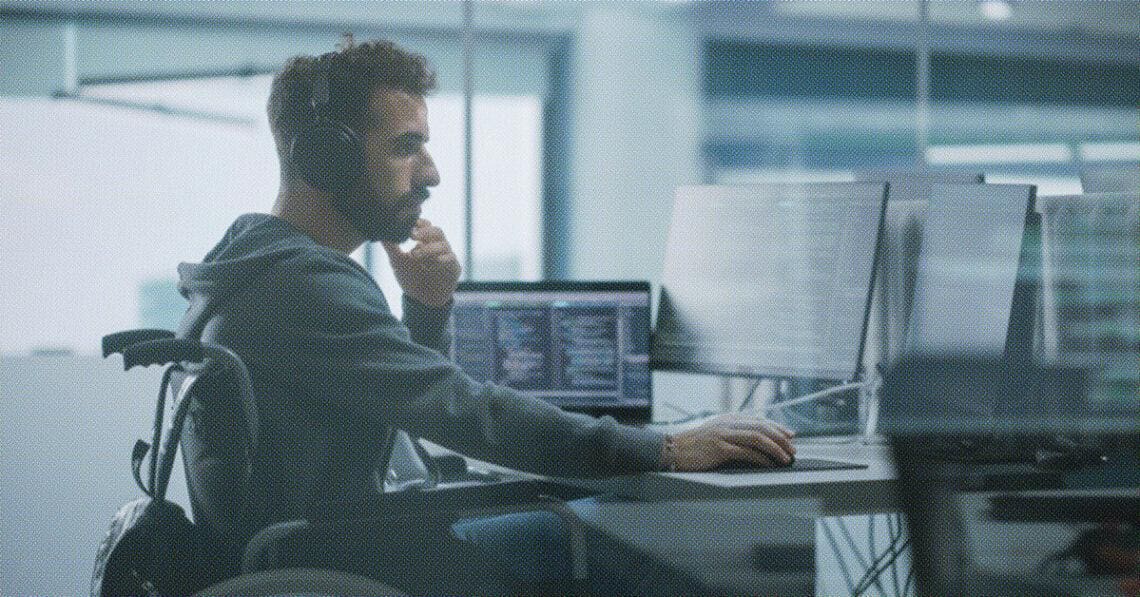Disability inclusion goes far beyond making sure your building is wheelchair-accessible. Creating a workplace that’s welcoming of those with disabilities, whether obvious or invisible, means giving them what they need, writes Honeywell chief HR counsel Lisa Morganstern Bickel.
The signing into law of the groundbreaking Americans with Disabilities Act (ADA) in the United States more than 30 years ago was a historic achievement toward equality for people with disabilities. The significant progress made since then is worth celebrating. The importance of vastly improved access to buildings, transportation and reasonable workplace accommodations for employees and job applicants cannot be overstated.
But in both the U.S. and globally, the work is far from complete. More must be done to eliminate barriers and promote a true sense of belonging for the 1.3 billion people worldwide living with a disability, 70% of whom have non-apparent disabilities like dyslexia or autism.
There have been many advances in the U.S. because of the ADA, but the fact is that disabled individuals still face barriers. They deal with inaccurate assumptions about their abilities, are underrepresented in the workplace, remain reluctant to self-identify and have higher rates of poverty than those without disabilities.
Evolving the conversation
One of the few silver linings to be found from the Covid-19 pandemic is that it advanced the conversation about disability in the workplace. It resulted in greater workplace acceptance and flexibility, remote work and importantly, a focus on the mental health and well-being of all employees. Corporate America has a unique opportunity to evolve the conversation around disability by taking actionable steps that further a sense of inclusion and belonging rather than focus simply on compliance and hiring statistics.
It is certainly gratifying to see more and more companies working to increase representation of individuals with disabilities and create a more diverse, inclusive workplace. However, according to the most recent Disability Equality Index, even at companies that are trying, reforming and measuring their disability inclusion, rates still hover around 3-4% of employees who are willing to self-identify as disabled in the workplace.
(Un)Safe Space: The Changing Picture of Workplace Violence
Incidents of workplace violence have become so commonplace that they often do not make the news anymore, even when they result in multiple victims. But both workplace homicides and workplace bullying have become more common over the past half-decade.
Read moreDetailsThe disability difference can be your business benefit
Research from Accenture shows that when companies adopt best practices for hiring people with disabilities, these workers outperform their peers — period. That includes 28% higher revenue, double the net income and 30% higher economic profit margins. Additionally, including people with disabilities increases innovation, improves productivity and fosters a better work environment.
There are more than 15 million people of working age living with disabilities in the U.S. Accenture’s research suggests that if companies embrace disability inclusion, they will gain access to a new talent pool of millions more people.
According to the Centers for Disease Control, 1 in 36 U.S. children has been identified with autism spectrum disorder (ASD), a developmental disability that can affect how people communicate, interact and learn. Neurodivergent individuals, like those on the autism spectrum, process information differently.
It is that different — and often unconventional — way of thinking that makes the neurodivergent excellent employees. Their ability to think differently can lead to greater innovation and creativity in the workplace. And in fact, neurodivergent individuals often possess highly sought-after job skills, such as the ability to focus intently on the same task for great periods of time, excellent math skills and a keen ability for recognizing patterns.
Accessibility matters
There is perhaps no better way to further inclusion and belonging than by ensuring accessibility. A truly accessible environment is about so much more than wider doorways, wheelchair ramps and braille touchpads at the ATM.
Accessibility also means providing flexible work options; well-being benefits that extend past traditional employee assistance programs and into ensuring the mental health of all employees; and encouraging employees to self-identify as having a disability because disability is a strength, not a weakness.
Thinking about how technology applications have become ubiquitous in our society, the importance of digital accessibility for people with disabilities simply cannot be overstated. A lack of digital accessibility can serve only to further exclude people with disabilities from the workplace, commerce, the supply chain and social opportunities.
The availability of accessible digital products generally is critically important to furthering inclusion. On average people spend 3 hours and 15 minutes on their phones per day, checking the devices an average of 58 times.
Accessibility and accommodation mean different things to different people
To foster an environment that is truly inclusive of people with disabilities, companies of all sizes need to carefully consider what digital accessibility looks like in their workplace and similarly what types of accommodations might be necessary. It is critically important to understand that the needs can vary greatly from one person with a disability to another. It is important to recognize that just because two employees may each have a mobility-related disability, that does not mean their needs are the same.
Employers and employees are best served by engaging directly with each other to ensure full inclusion in the workplace. Opening up the lines of communication allows employees and job candidates the opportunity to succeed and deliver strong results for their employer.
Employers who are newer on the path to inclusion and accessibility might wish to consider the following examples of accommodations as a starting point; remember that people are unique — and these things may be the bare minimum required to get the best out of your team.
| Hearing disabilities | Visual disabilities | Neurodiversity |
| Closed captions | Keyboard aids | Flexible schedule |
| Audio loop | Large print (magnified screens and materials) | Visual aids |
| American Sign Language | Glare protectors | Noise-canceling headphones |
| Assistive listening device | Screen reading software | Alterations to light, sound and temperature |
| Text/video relay | Speech recognition | Workspace alterations |
| Visual emergency notifications | Braille tools (printer, note taking tools, translation software) | |
| Work area modifications (such as away from noise) |
The future is now
Around the globe, 386 million working-age people have disabilities. In the U.S., the labor force participation rate for people with disabilities is 40% lower than their non-disabled peers. This figure represents a huge portion of the workforce that is being overlooked — and this has a trickle-down effect on all aspects of economic life and social independence.
People with disabilities are truly the last bastion of underrepresentation and unemployment, yet they possess unique talents derived from the perspectives and experiences they have gained trying to fit into a world that simply was not made for them. These talents are waiting to be called upon.




 Lisa Morganstern Bickel is the chief labor and employment counsel for Honeywell’s aerospace strategic business group and is also responsible for advising the company enterprise-wide on its strategic approach to affirmative action, Office of Federal Contract Compliance Programs compliance and staffing. Lisa is chairperson of Honeywell’s AllAbilities Employee Network, which she views as a path to advance inclusion in the workplace by showcasing how employees with different abilities drive innovation and growth. Lisa was named the 2022 Executive Sponsor of the Year by Disability:IN, the leading nonprofit resource for driving disability inclusion in business.
Lisa Morganstern Bickel is the chief labor and employment counsel for Honeywell’s aerospace strategic business group and is also responsible for advising the company enterprise-wide on its strategic approach to affirmative action, Office of Federal Contract Compliance Programs compliance and staffing. Lisa is chairperson of Honeywell’s AllAbilities Employee Network, which she views as a path to advance inclusion in the workplace by showcasing how employees with different abilities drive innovation and growth. Lisa was named the 2022 Executive Sponsor of the Year by Disability:IN, the leading nonprofit resource for driving disability inclusion in business. 








